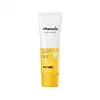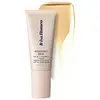What's inside
What's inside
 Key Ingredients
Key Ingredients

 Benefits
Benefits

 Concerns
Concerns

 Ingredients Side-by-side
Ingredients Side-by-side

Water
Skin ConditioningDibutyl Adipate
EmollientMethylpropanediol
SolventAlcohol Denat.
AntimicrobialTerephthalylidene Dicamphor Sulfonic Acid
UV Absorber1,2-Hexanediol
Skin ConditioningEthylhexyl Triazone
UV AbsorberGlycerin
HumectantNiacinamide
SmoothingPolysilicone-15
UV FilterTromethamine
BufferingPolyglyceryl-3 Distearate
EmulsifyingCaprylyl Methicone
Skin ConditioningCetearyl Alcohol
EmollientDiethylamino Hydroxybenzoyl Hexyl Benzoate
UV FilterDipropylene Glycol
HumectantPolymethylsilsesquioxane
Palmitic Acid
EmollientStearic Acid
CleansingBis-Ethylhexyloxyphenol Methoxyphenyl Triazine
Skin ConditioningGlyceryl Stearate
EmollientPotassium Cetyl Phosphate
EmulsifyingPolyether-1
Carbomer
Emulsion StabilisingAmmonium Acryloyldimethyltaurate/Vp Copolymer
Glyceryl Stearate Citrate
EmollientAcrylates/C10-30 Alkyl Acrylate Crosspolymer
Emulsion StabilisingEthylhexylglycerin
Skin ConditioningPanthenol
Skin ConditioningAdenosine
Skin ConditioningButylene Glycol
HumectantPoncirus Trifoliata Fruit Extract
Skin ConditioningHydrolyzed Hyaluronic Acid
HumectantCitrus Limon Fruit Extract
MaskingThiamine Hcl
MaskingSodium Hyaluronate
HumectantAscorbic Acid
AntioxidantBioflavonoids
Skin ConditioningGlutathione
Tocopheryl Acetate
AntioxidantHyaluronic Acid
HumectantParfum
MaskingWater, Dibutyl Adipate, Methylpropanediol, Alcohol Denat., Terephthalylidene Dicamphor Sulfonic Acid, 1,2-Hexanediol, Ethylhexyl Triazone, Glycerin, Niacinamide, Polysilicone-15, Tromethamine, Polyglyceryl-3 Distearate, Caprylyl Methicone, Cetearyl Alcohol, Diethylamino Hydroxybenzoyl Hexyl Benzoate, Dipropylene Glycol, Polymethylsilsesquioxane, Palmitic Acid, Stearic Acid, Bis-Ethylhexyloxyphenol Methoxyphenyl Triazine, Glyceryl Stearate, Potassium Cetyl Phosphate, Polyether-1, Carbomer, Ammonium Acryloyldimethyltaurate/Vp Copolymer, Glyceryl Stearate Citrate, Acrylates/C10-30 Alkyl Acrylate Crosspolymer, Ethylhexylglycerin, Panthenol, Adenosine, Butylene Glycol, Poncirus Trifoliata Fruit Extract, Hydrolyzed Hyaluronic Acid, Citrus Limon Fruit Extract, Thiamine Hcl, Sodium Hyaluronate, Ascorbic Acid, Bioflavonoids, Glutathione, Tocopheryl Acetate, Hyaluronic Acid, Parfum
Zinc Oxide 10%
Cosmetic ColorantAllantoin
Skin ConditioningAscorbyl Glucoside
AntioxidantBisabolol
MaskingButyloctyl Salicylate
Skin ConditioningC12-15 Alkyl Benzoate
AntimicrobialC26-28 Alkyl Dimethicone
Skin ConditioningCaprylic/Capric Triglyceride
MaskingCaprylyl Glycol
EmollientCaprylyl Methicone
Skin ConditioningDimethicone
EmollientGlycerin
HumectantHydrogenated Lecithin
EmulsifyingHydroxyethyl Dimethicone
Iron Oxides
Jojoba Esters
EmollientLecithin
EmollientMethylpropanediol
SolventMica
Cosmetic ColorantNiacinamide
SmoothingPhenylpropanol
MaskingPolyglyceryl-2 Dipolyhydroxystearate
Skin ConditioningPolyglyceryl-3 Diisostearate
EmulsifyingPolyglyceryl-3 Polyricinoleate
EmulsifyingPolyglyceryl-4 Diisostearate/Polyhydroxystearate/Sebacate
EmulsifyingPyrus Malus Fruit Extract
Skin ConditioningSilica
AbrasiveSodium Chloride
MaskingSodium Hydroxide
BufferingStearalkonium Hectorite
Gel FormingTetrasodium Glutamate Diacetate
Tin Oxide
AbrasiveTitanium Dioxide
Cosmetic ColorantTocopherol
AntioxidantWater
Skin ConditioningZinc Oxide 10%, Allantoin, Ascorbyl Glucoside, Bisabolol, Butyloctyl Salicylate, C12-15 Alkyl Benzoate, C26-28 Alkyl Dimethicone, Caprylic/Capric Triglyceride, Caprylyl Glycol, Caprylyl Methicone, Dimethicone, Glycerin, Hydrogenated Lecithin, Hydroxyethyl Dimethicone, Iron Oxides, Jojoba Esters, Lecithin, Methylpropanediol, Mica, Niacinamide, Phenylpropanol, Polyglyceryl-2 Dipolyhydroxystearate, Polyglyceryl-3 Diisostearate, Polyglyceryl-3 Polyricinoleate, Polyglyceryl-4 Diisostearate/Polyhydroxystearate/Sebacate, Pyrus Malus Fruit Extract, Silica, Sodium Chloride, Sodium Hydroxide, Stearalkonium Hectorite, Tetrasodium Glutamate Diacetate, Tin Oxide, Titanium Dioxide, Tocopherol, Water
Ingredients Explained
These ingredients are found in both products.
Ingredients higher up in an ingredient list are typically present in a larger amount.
Caprylyl Methicone is a type of silicone.
It helps soften and soothe the skin by creating a thin film on top. This film helps trap moisture, keeping your skin hydrated.
Glycerin is already naturally found in your skin. It helps moisturize and protect your skin.
A study from 2016 found glycerin to be more effective as a humectant than AHAs and hyaluronic acid.
As a humectant, it helps the skin stay hydrated by pulling moisture to your skin. The low molecular weight of glycerin allows it to pull moisture into the deeper layers of your skin.
Hydrated skin improves your skin barrier; Your skin barrier helps protect against irritants and bacteria.
Glycerin has also been found to have antimicrobial and antiviral properties. Due to these properties, glycerin is often used in wound and burn treatments.
In cosmetics, glycerin is usually derived from plants such as soybean or palm. However, it can also be sourced from animals, such as tallow or animal fat.
This ingredient is organic, colorless, odorless, and non-toxic.
Glycerin is the name for this ingredient in American English. British English uses Glycerol/Glycerine.
Learn more about GlycerinMethylpropanediol is a synthetic solvent and humectant.
As a solvent, it helps dissolve other ingredients, helping to evenly distribute ingredients throughout the product. This ingredient has also been shown to have antimicrobial properties which makes it a preservative booster.
Methylpropanediol is able to add a bit of moisture to the skin. It also helps other ingredients be better absorbed into the skin, such as salicylic acid.
Learn more about MethylpropanediolNiacinamide is a multitasking form of vitamin B3 that strengthens the skin barrier, reduces pores and dark spots, regulates oil, and improves signs of aging.
And the best part? It's gentle and well-tolerated by most skin types, including sensitive and reactive skin.
You might have heard of "niacin flush", or the reddening of skin that causes itchiness. Niacinamide has not been found to cause this.
In very rare cases, some individuals may not be able to tolerate niacinamide at all or experience an allergic reaction to it.
If you are experiencing flaking, irritation, and dryness with this ingredient, be sure to double check all your products as this ingredient can be found in all categories of skincare.
When incorporating niacinamide into your routine, look out for concentration amounts. Typically, 5% niacinamide provides benefits such as fading dark spots. However, if you have sensitive skin, it is better to begin with a smaller concentration.
When you apply niacinamide to your skin, your body converts it into nicotinamide adenine dinucleotide (NAD). NAD is an essential coenzyme that is already found in your cells as "fuel" and powers countless biological processes.
In your skin, NAD helps repair cell damage, produce new healthy cells, support collagen production, strengthen the skin barrier, and fight environmental stressors (like UV and pollution).
Our natural NAD levels start to decline with age, leading to slower skin repair, visible aging, and a weaker skin barrier. By providing your skin niacinamide, you're recharging your skin's NAD levels. This leads to stronger, healthier, and younger looking skin.
Another name for vitamin B3 is nicotinamide. This vitamin is water-soluble and our bodies don't store it. We obtain Vitamin B3 from either food or skincare. Meat, fish, wheat, yeast, and leafy greens contain vitamin B3.
The type of niacinamide used in skincare is synthetically created.
Learn more about NiacinamideWater. It's the most common cosmetic ingredient of all. You'll usually see it at the top of ingredient lists, meaning that it makes up the largest part of the product.
So why is it so popular? Water most often acts as a solvent - this means that it helps dissolve other ingredients into the formulation.
You'll also recognize water as that liquid we all need to stay alive. If you see this, drink a glass of water. Stay hydrated!
Learn more about Water